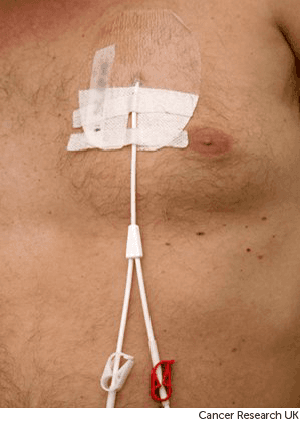Chemotherapy into your vein (Intravenous)
You might have chemotherapy into the bloodstream through a long flexible plastic tube called a central line.
They are called central lines because they end up in a central blood vessel in your chest, close to your heart.

There are different types of central line:
acute central line
tunnelled central line
peripherally inserted central catheter (PICC line)
portacath or totally implantable venous access device (TIVAD)
This page is about acute and tunnelled central lines.
Find out more about chemotherapy into a vein
An acute central line goes in through a vein in your neck. It is used for short term treatments. You might have one if you need treatment urgently or it is difficult to find a vein for a cannula.
A skin tunnelled central line goes in through your chest. It goes under your skin and into a large vein by your collarbone. The only bit you can see is the length of line that hangs out of the small entry hole in your chest.
At the end of the length of line that you can see, there are connection ports where the nurse attaches your chemotherapy. The connection ports are kept closed with caps.
This is a picture of a skin tunnelled central line in place.

Before a skin tunnelled line is inserted, you have a local or general anaesthetic. Sometimes doctors use continuous x-rays as they put the tube in, so they can see where it’s going. Your doctor may want you to have an x-ray afterwards to make sure the end of the tube is in the best place.
When the tunnelled line is in, they will stitch it in place or put special dressings over it, so it can't come out. The stitches are removed after about a week. There is also a small cuff on the line, which is under the skin and holds it in place. You can move about normally. It won't come out while you’re sleeping or dressing.
The tunnelled line can stay in your vein for many months. So you won't need to have needles into your hand or arm each time you have your chemotherapy treatment.
Your doctor and nurse can also take blood from the line for tests. They can also use the line to give you fluids or other treatment such as antibiotics if you need them.
The video below shows how a tunnelled central line is put in. It is 1 minute and 47 seconds long.
Sometimes problems can happen with tunnelled central lines:
you may get an infection
the line may get blocked
a blood clot can develop
the line may split, but this is very rare
Your nurse will test your tunnelled central line each time they use it. They will check for blood return and inject it with salt water (saline). This is called flushing. It’s very important to tell your nurse if you experience pain as the line is flushed or during chemotherapy. This could mean the line has split.
If you are not having treatment regularly, you or your nurse needs to clean and flush the line weekly. This will keep it clear and stop any problems developing. It is flushed with and saline to clean the line and prevent clotting. The nurses on the ward can teach you or your carer how to do this. Your district nurse can care for your line or help you at home at first.
It’s very important to avoid getting an infection in the area where your line goes into your body. Speak to your chemotherapy nurse or doctor if you notice any redness, swelling, oozing or soreness. These could be signs of infection.
You’ll need to have treatment with antibiotics straight away if you do develop an infection. Otherwise, a doctor or nurse may have to remove the line and put a new one in.
You can go home with a central line in place. There are very few restrictions to your everyday life.
It’s fine to have a bath or shower. Don't let your line go under water in the bath.
Before you go home, make sure you’re confident about looking after your line. Ask the staff on the ward if you’re not sure about anything. They can arrange for district nurses to visit you at home to help with the line until you feel confident.
Contact your advice line if you have any problems at home.
Last reviewed: 16 May 2024
Next review due: 17 May 2027
Search for the cancer type you want to find out about.
Treatments can include surgery, radiotherapy and drug treatments (such as chemotherapy, hormone therapy or targeted cancer drugs). Find out about treatments and how to cope with side effects.
People usually have chemotherapy either at home, in hospital or at a day clinic. There are different ways of having chemotherapy drugs. Your doctor will talk about the most suitable option for you.
Some of the by-products of systemic anti cancer therapy (SACT) come out of your body in your vomit, wee, poo, blood or other bodily fluids during and for some time after your treatment. This can be harmful to others. So you must take precautions if you go home.
Chemotherapy might affect your everyday life, from the way you feel to socialising and holidays. You can get tips and support to help you cope.
Chemotherapy is a standard treatment for some types of cancer. It uses anti cancer drugs to destroy cancer cells.

About Cancer generously supported by Dangoor Education since 2010. Learn more about Dangoor Education
What to ask your doctor about clinical trials.
Meet and chat to other cancer people affected by cancer.
Questions about cancer? Call freephone 0808 800 40 40 from 9 to 5 - Monday to Friday. Alternatively, you can email us.